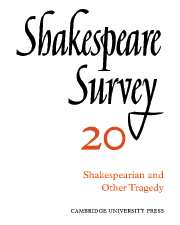Book contents
- Frontmatter
- Shakespeare, Fletcher and Baroque Tragedy
- Seneca and the Elizabethans: A Case-study in ‘Influence’
- George Chapman: Tragedy and the Providential View of History
- Critical Disagreement about Oedipus and Hamlet
- Shakespeare’s Thematic Modes of Speech: ‘Richard II’ to ‘Henry V’
- Anarchy and Order in ‘Richard III’ and ‘King John’
- The Staging of Parody and Parallels in ‘I Henry IV’
- Shakespeare’s Unnecessary Characters
- Walter Whiter’s Notes on Shakespeare
- Shakespeare’s ‘Romeo and Juliet’: Its Spanish Source
- The Grieves Shakespearian Scene Designs
- Shakespeare on the Modern Stage: Past Significance and Present Meaning
- Shakespeare in Brazil
- Recent Shakespeare Performances in Romania
- Shakespeare, the Twentieth Century and ‘Behaviourism’
- The Year's Contributions to Shakespearian Study 1 Critical Studies
- 2 Shakespeare’s Life, Times and Stage
- 3 Textual Studies
- Index
- Plate section
Shakespeare in Brazil
Published online by Cambridge University Press: 28 March 2007
- Frontmatter
- Shakespeare, Fletcher and Baroque Tragedy
- Seneca and the Elizabethans: A Case-study in ‘Influence’
- George Chapman: Tragedy and the Providential View of History
- Critical Disagreement about Oedipus and Hamlet
- Shakespeare’s Thematic Modes of Speech: ‘Richard II’ to ‘Henry V’
- Anarchy and Order in ‘Richard III’ and ‘King John’
- The Staging of Parody and Parallels in ‘I Henry IV’
- Shakespeare’s Unnecessary Characters
- Walter Whiter’s Notes on Shakespeare
- Shakespeare’s ‘Romeo and Juliet’: Its Spanish Source
- The Grieves Shakespearian Scene Designs
- Shakespeare on the Modern Stage: Past Significance and Present Meaning
- Shakespeare in Brazil
- Recent Shakespeare Performances in Romania
- Shakespeare, the Twentieth Century and ‘Behaviourism’
- The Year's Contributions to Shakespearian Study 1 Critical Studies
- 2 Shakespeare’s Life, Times and Stage
- 3 Textual Studies
- Index
- Plate section
Summary
The short and sad story of Shakespeare in Brazil is, by and large, the story of a few translations that often are either un-Shakespearian or not stageworthy (or both, which is worse). The burden of the rhymed alexandrine weighs heavily on Brazil’s literary and dramatic past (which is only natural, since all its literary vogues come from Portugal, which had them from France). The problem still exists, and we shall see that in the Brazilian theatre Shakespeare has been more a patron saint than a fellow-worker.
The first professional performances of Shakespeare in the country date from about 1835, in the form of Portuguese translations and adaptations of French adaptations. The records do not speak of Romeo and Juliet but of 'TheTombs at Verona or Juliet and Romeo', and of'The Terrible Effects of Hatred and Vengeance or Julietand Romeo', as well as of 'Coriolanus in Rome' and, somewhat later, of 'Ducis's Othello'.
The first actor to be identified with Shakespearian roles—and the only one, in fact, for over a century—was João Caetano dos Santos, the most famous name of the Brazilian theatrical past. Surprisingly (or, to be more precise, regrettably) enough, although in 1835 João Caetano is said to have been acting in a direct translation from the English original of Hamlet, by 1840 he was using Ducis's adaptation, which the public found much more enjoyable than the sombre tones of Shakespeare's tragedy. In short, it will hardly be news to anyone that Ducis was historically justified.
- Type
- Chapter
- Information
- Shakespeare Survey , pp. 121 - 124Publisher: Cambridge University PressPrint publication year: 1967

